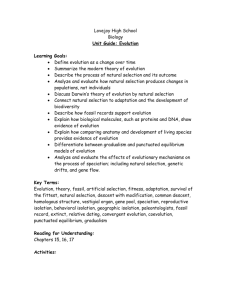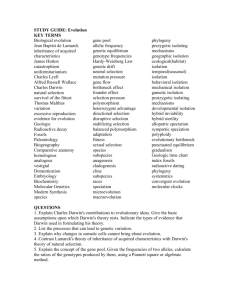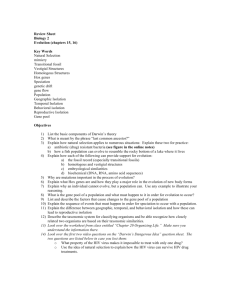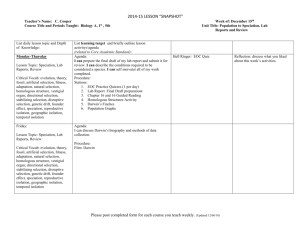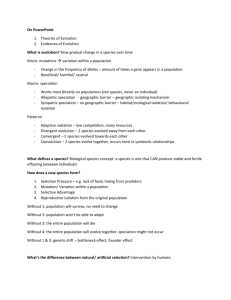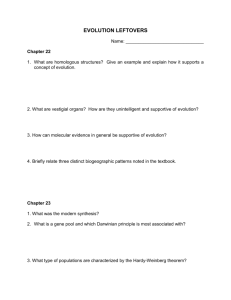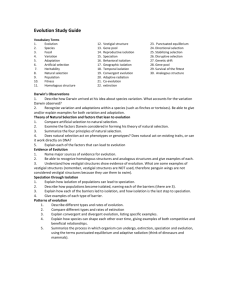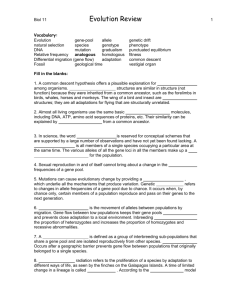AP Biology Evolution Unit Lesson Plans & Study Guide
advertisement
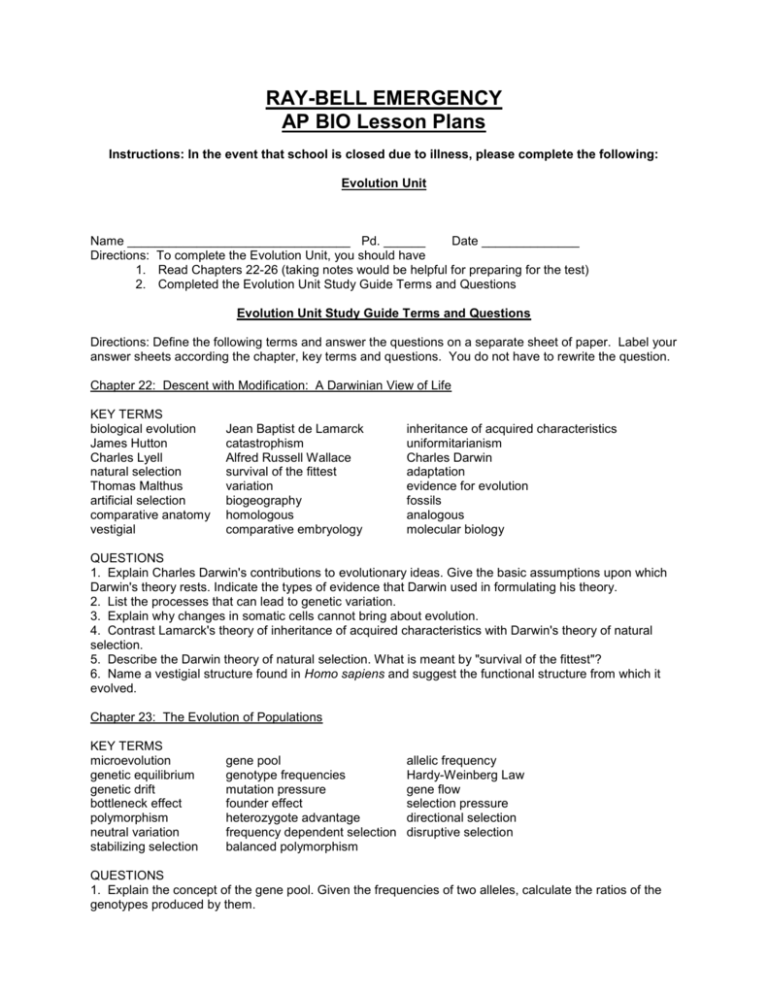
RAY-BELL EMERGENCY AP BIO Lesson Plans Instructions: In the event that school is closed due to illness, please complete the following: Evolution Unit Name ________________________________ Pd. ______ Date ______________ Directions: To complete the Evolution Unit, you should have 1. Read Chapters 22-26 (taking notes would be helpful for preparing for the test) 2. Completed the Evolution Unit Study Guide Terms and Questions Evolution Unit Study Guide Terms and Questions Directions: Define the following terms and answer the questions on a separate sheet of paper. Label your answer sheets according the chapter, key terms and questions. You do not have to rewrite the question. Chapter 22: Descent with Modification: A Darwinian View of Life KEY TERMS biological evolution James Hutton Charles Lyell natural selection Thomas Malthus artificial selection comparative anatomy vestigial Jean Baptist de Lamarck catastrophism Alfred Russell Wallace survival of the fittest variation biogeography homologous comparative embryology inheritance of acquired characteristics uniformitarianism Charles Darwin adaptation evidence for evolution fossils analogous molecular biology QUESTIONS 1. Explain Charles Darwin's contributions to evolutionary ideas. Give the basic assumptions upon which Darwin's theory rests. Indicate the types of evidence that Darwin used in formulating his theory. 2. List the processes that can lead to genetic variation. 3. Explain why changes in somatic cells cannot bring about evolution. 4. Contrast Lamarck's theory of inheritance of acquired characteristics with Darwin's theory of natural selection. 5. Describe the Darwin theory of natural selection. What is meant by "survival of the fittest"? 6. Name a vestigial structure found in Homo sapiens and suggest the functional structure from which it evolved. Chapter 23: The Evolution of Populations KEY TERMS microevolution genetic equilibrium genetic drift bottleneck effect polymorphism neutral variation stabilizing selection gene pool genotype frequencies mutation pressure founder effect heterozygote advantage frequency dependent selection balanced polymorphism allelic frequency Hardy-Weinberg Law gene flow selection pressure directional selection disruptive selection QUESTIONS 1. Explain the concept of the gene pool. Given the frequencies of two alleles, calculate the ratios of the genotypes produced by them. 2. State the Hardy-Weinberg Law, and discuss its four conditions for maintenance of genetic equilibrium. Why are these conditions rarely met in nature? 3. Explain how natural selection in one generation can affect the genotype of the next generation. 4. Using diagrams, contrast directional selection, stabilizing selection and disruptive selection. 5. Contrast the roles of selection and mutation in directing evolutionary change. 6. Explain how a characteristic can have both positive and negative effects and indicate what determines whether or not a trait will increase or decrease in a population. PROBLEMS 1. A certain homozygous recessive geneotype occurs in 4% of a population. What is the frequency of its two alleles, T and t? 2. What percentage of the population is heterozygous (Tt) ? 3. In a certain species of plant where red and white flowers are determined by a single pair of alleles, R (red) and r (white), a grower counted 90 white flowering plants in a field of 1000. If random pollination is occurring, what proportion of the field is heterozygous? 4. In the United States, 16% of the population is Rh-, due to a homozygous recessive pair of alleles. From this data, determine: a. the frequency of the recessive gene b. the frequency of the dominant gene c. the percentage of heterozygotes in the population 5. A certain gene (k) is recessive; the dominant gene (K) is one of the genes necessary to produce chlorophyll in plant leaves. In a particular variety of corn, 36% of the seedlings are found to lack chlorophyll and appear yellow when they sprout, then die. Determine: a. the frequency of K b. the frequency of k c. the percentage of individuals that are Kk 6. About 1 in 10,000 Caucasians born in the U.S.A. have the homozygous recessive condition where they lack the ability to produce the enzyme PKU. Without treatment, this is a fatal condition. a. What is the frequency of the recessive gene? b. What percentage of individuals are heterozygous? Chapter 24: The Origin of Species species anagenesis cladogenesis races speciation microevolution macroevolution phyletic evolution biological species concept prezygotic barriers habitat isolation temporal isolation behavioral isolation mechanical isolation gametic isolation postzygotic barriers hybrid inviability hybrid sterility hybrid breakdown morphological species concept cohesion species concept ecological species concept evolutionary species concept allopatric speciation sympatric speciation adaptive radiation polyploidy autopolyploid alloopolyploid hybrid zone punctuated equilibrium gradualism novel features QUESTIONS 1. Give a biological definition of species. 2. Describe speciation by polyploidy. 3. Explain what is meant by adaptive radiation, and discuss the evidence for this phenomenon. 4. Compare the hypotheses of gradualism and punctuated equilibrium, and give an example supporting each hypothesis. 5. Explain why the modern concept of the species is difficult to apply to sexual organisms, fossil organisms, populations at an intermediate stage of divergence and allopatric populations. 6. Discuss allopatric speciation. 7. Compare and contrast punctuated equilibrium and gradualism. How would you support your favorite theory? 8. Discuss and give an example of how each of the following isolating mechanisms contributes to speciation in organisms: A. Geographical barriers B. Ecological (including seasonal) isolation C. Behavioral isolation D. Polyploidy Chapter 26: Tracing Phylogeny KEY TERMS Carolus Linneaus systematics phylogeny heirarchy Kingdom Phylum(Division) Order Family Species binomial nomenclature radiometric data mass extinction monophyletic polyphyletic analogy convergent evolution cladistics cladogram derived characters (synamorphies) taxonomy taxon (pl. taxa) Class Genus fossil record phylogenetic tree homology phenetics clade primitive characters QUESTIONS 1. Why does a taxonomist need an in depth understanding of biological evolution? 2. What can cladograms tell us? What can’t they tell us? 3. List types of criteria that are used to classify organisms. Include in your answer a discussion of homology and analogy. 4. Describe the Linnean system of classification. 5. Name the five Kingdoms, give examples and list the characteristics of each.
